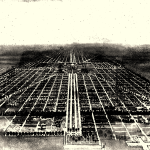The verb “descend” (katabaino) is used ten times in Revelation, and the uses form a neat pattern:
A. Jerusalem (3:12)
B. Angel in cloud with book (10:1)
C. Devil (12:12)
D. Fire of false prophet (13:13)
E. Hailstones (16:21)
B’. Angel with glory (18:1)
C’. Angel to bind dragon (20:1)
D’. Fire to devour Satan and armies(20:9)
A’. New Jerusalem (2x; 21:2, 10)
The sequence is framed by three references to the descent of “new Jerusalem,” the first a promise (3:12) and the last two to the vision of Jerusalem actually descending (21:2, 10).
The B-D sequence describes threats to the saints. The Angel descends with a book of bitter prophecies that John speaks over the course of several chapters. These involve the descent of Satan to the earth (12:12), the call of the sea beast, and the successful deception of the land beast, who can call fire to descend from heaven (13:13). B’-D’ reverses the initial sequence. Another angel descends to announce the fall of Babylon, the city allied with the beasts (18:1), then an angel descends with a chain to bind Satan (20:1). Fire falls, but this time it’s not summoned by the land beast; it is God’s fire that consumes Satan and his assembled armies (20:9). The B’-D’ sequence of descents prepares the way for the climactic descent of the bridal city, as Jesus promised.
The one unique descent is in 16:21, the “coming down” of monstrous hailstones. That is suitably placed in the center between the threatening events recorded in B-D and the deliverance described in B’-D’. Hailstones are pieces of the firmament, and when hail falls in Revelation it means that the sky is breaking apart. A world comes to an end as the boundary between heaven and earth is shattered, making way for delivering angels, fire from heaven, and a new Jerusalem.










